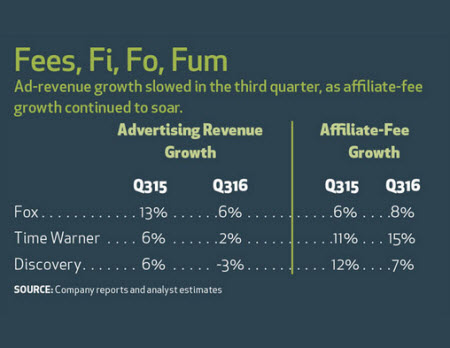Q3 May Bring Harsh Fall for Nets

Despite continued declines in the pay TV sector, programmers continued to report strong affiliate-fee increases in the third quarter. The results indicate that live, on-demand and other programming offerings may still have value, but skeptics said programmers are in for a big surprise as old deals roll off.
Content providers for the most part have been losing an average of about 2% of their subscribers in the past several quarters. The losses mainly reflect a growing shift away from traditional television viewing to over-the-top and mobile services such as AT&T’s upcoming DirecTV Now, slated for a mid-November launch, and more-established services like Sony’s PlayStation Vue, Amazon Video and Hulu Plus.
RATINGS SHRINK, FEES GROW
But while fewer subscribers has led to lower ratings and slower ad-revenue growth for most of the major programmers, affiliate fees continue to climb.
While that may just be a factor of different license renewal cycles and higher pricing, it could also mean that the traditional, linear pay TV network has more value than some critics think.
For programmers, the litmus test may be 21st Century Fox, which expects between 15% and 20% of its programming footprint to come up for renewal by the end of the year. 21st Century Fox, parent of the Fox broadcast network and news and entertainment programmers such as Fox News Channel, Fox Business Network and FX, reported an 8% increase in affiliate fees in the fiscal first quarter, up from a 6% increase in fiscal Q4. And the company said that it expects affiliate revenue to continue to grow at that pace or higher as new deals come online.
What intrigued some analysts, though, is that Fox claimed the increased affiliate fees didn’t come from higher pricing, but from greater volume. Fox channels actually added subscribers in the fiscal first quarter, bucking the recent trend.
Multichannel Newsletter
The smarter way to stay on top of the multichannel video marketplace. Sign up below.
Fox attributed the subscriber increases to the movement of networks like FX, movie channel FXM and sports network FS2 into broader bundles and new deals with over-the-top distributors.
Fox already has deals with Sling TV, PlayStation Vue, Amazon Fire TV, Apple TV and is reportedly close to finalizing an agreement to be included in DirecTV Now. The programmer, a partner in the online video service Hulu with Comcast’s NBCUniversal and The Walt Disney Co., will also appear in that company’s live streaming service expected early next year.
On a conference call with analysts to discuss its earnings results last week, Fox CEO James Murdoch said that while some of the upcoming Fox News renewals are for older contracts that could see a hefty price increase to align them with other distributors, “the channel is as strong as ever.”
“We feel that the product has enormous amount of value to customers and that’s reflected in its ability to and our ability to continually grow those affiliate fees,” Murdoch said on the call.
It may be a little early to call this a new trend, MoffettNathanson senior research analyst Michael Nathanson wrote in a client note. But he added the Fox difference could be tied to its programming mix — live sports on the Fox network, sports channels like FS1, FS2 and regional sports channels, as well as general-entertainment programming on FX, FXX and Fox.
“We continue to believe that owners of must-have, live, scaled content (like Fox) have pricing power despite the consolidation of the MVPD industry,” Nathanson wrote.
Fox still needs to prove it can grow affiliate fees in the latter half of the year and show some non-programming related cost discipline at its cable networks, according to Nathanson. “The first quarter is a good start in the right direction,” Nathanson wrote.
FOX AN OUTLIER?
Telsey Advisory Group media analyst Tom Eagan attributed most of the Fox subscriber gain to its “emerging networks” like FS2. He added that other programmers probably won’t see the same result because they don’t have as many emerging networks.
Barclays media analyst Kannan Venkateshwar agreed. In a note to clients, he said the growth was due to newer channels like FXM, Fox Business and FS2 getting broader distribution.
“[I]t is not clear how sustainable this trend is given these are likely noncore networks, especially in a skinny bundle world,” Venkateshwar wrote.
Still, Eagan said he believes the next renewal cycle will be difficult for programmers, as distributors point to lower ratings and declining subscribers to push for lower fees.
“For the more independent networks, it’s going to be more challenging,” Eagan said.
